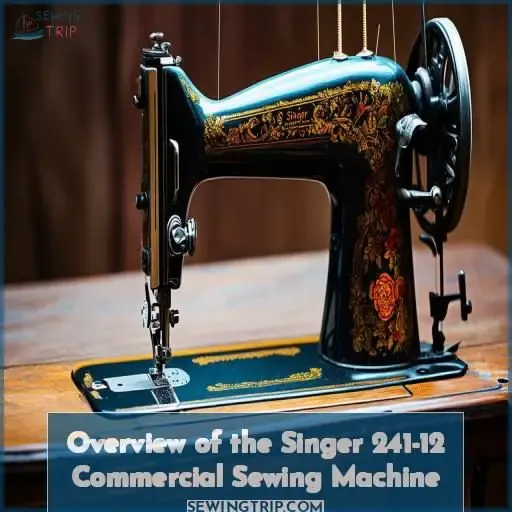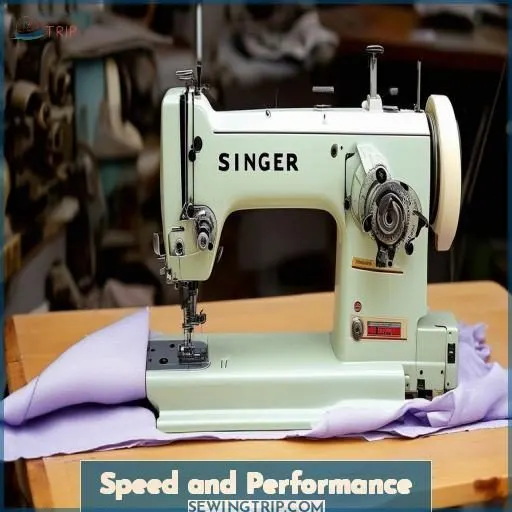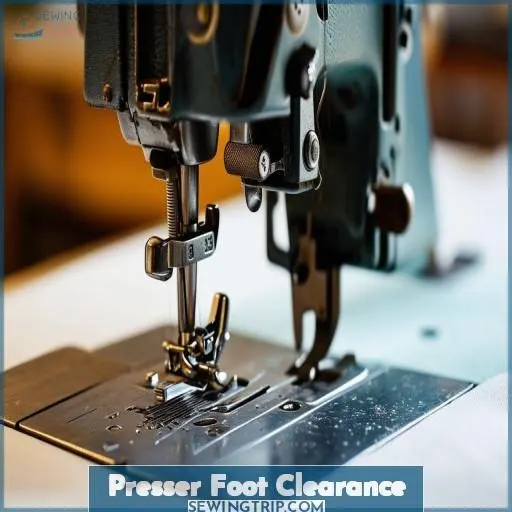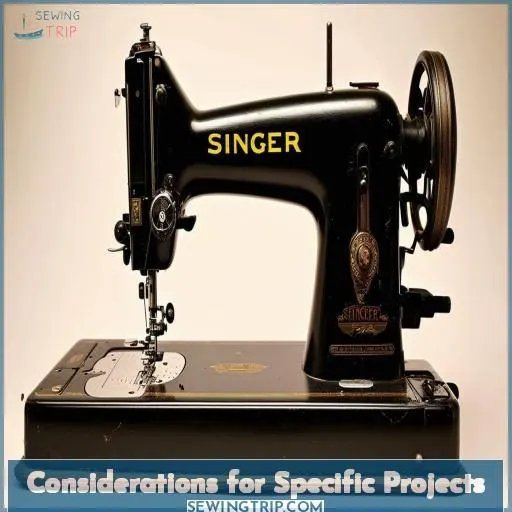This site is supported by our readers. We may earn a commission, at no cost to you, if you purchase through links.
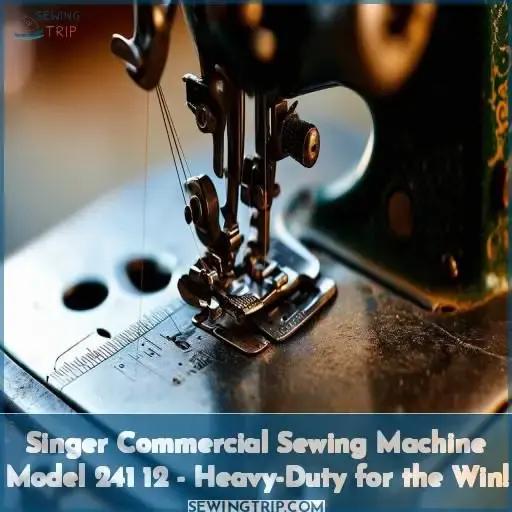
It handles heavy threads with ease, ensuring robust stitching on hefty projects. With a 3/8" presser foot clearance, it’s perfect for tasks that require precision and power. Plus, its high-speed operation is ideal for projects that demand efficiency.
Interested in more details and ensuring it fits your needs? There’s plenty more to discover about its impressive features and performance.
Table Of Contents
Key Takeaways
- The Singer 241-12 commercial sewing machine is like a race car for your sewing projects, zipping through them at high speeds.
- This workhorse can handle even the heaviest of fabrics and threads, making it perfect for tasks that require some muscle.
- With its large presser foot clearance, you can easily sew through multiple layers of fabric or bulky materials without getting stuck.
- The machine’s oil bath lubrication system keeps things running smoothly, even during extended use.
Overview of the Singer 241-12 Commercial Sewing Machine
The Singer 241-12 commercial sewing machine is a sump type machine with an oil bath at the bottom, a mechanical pump that circulates the oil, and a window with a drip tube for monitoring the oil level. It can handle heavy-duty threads, making it suitable for projects requiring strong, durable stitching.
Sump Type Machine With Oil Bath in Bottom
The sump type Singer 241-12 features an oil bath at the bottom, guaranteeing optimal lubrication. While convenient, be mindful of potential oil stains on fabrics. The drip tube and window allow you to monitor oil levels easily, essential for maintaining this high-speed machine. Proper oil maintenance ensures smooth operation and longevity.
Mechanical Pump Circulates Oil
You’ll appreciate how a mechanical pump circulates the oil, ensuring proper lubrication without hassle. Maintaining the right oil viscosity is essential for smooth operation and prolonged pump lifespan. While oil staining on leather projects is a concern, strategic drip tube placement minimizes mess during oil circulation. Before purchasing, test the pump’s functionality to avoid issues down the line.
Window With Drip Tube for Oil Visibility
You’ll love the machine’s window with drip tube, allowing you to:
- Monitor oil circulation and viscosity
- Spot potential oil leaks early
- Plan oil changes for efficient maintenance
While the oil bath provides smooth operation, be mindful of potential stains on leather projects. However, proper care guarantees your Singer 241-12 runs seamlessly.
Capable of Using Heavy Thread for Strong Stitching
What’s more, you’ll find this machine capable of heavy-duty stitching with strong thread. Perfect for thick fabrics like leather upholstery or industrial-grade sewing projects, the 241-12 can handle the demands of your toughest jobs. So bring on those robust materials – this workhorse is ready to deliver durable, reinforced seams that’ll withstand serious wear and tear.
Speed and Performance
You’ll find that the Singer 241-12 commercial sewing machine is an incredibly fast performer, zipping through projects at a pace much quicker than typical models. However, as you become accustomed to its rapid speed, you may eventually feel that it’s still not quite fast enough for certain demanding projects requiring maximum efficiency.
High Speed Machine, Faster Than Typical Models
Speaking of speed, you’ll be pleasantly surprised by how fast this machine operates compared to typical models. Its high-speed capability allows you to tackle projects requiring swiftness and efficiency with precision. However, be mindful of thread tension, bobbin capacity, and stitch quality when working at such speeds to maintain ideal performance and noise levels.
User May Become Accustomed to the Speed
In time, you’ll become accustomed to this machine’s fast pace, seamlessly adjusting to its speed. However, mastering the needle thickness, foot pressure, and motor performance is essential for effective project execution. Assess whether the speed aligns with your specific needs, ensuring a smooth and efficient workflow.
Speed May Eventually Feel Too Slow for Some Projects
While you’ll initially revel in the machine’s blistering pace, there may come a time when even its dizzying speed feels sluggish for certain projects. Consider:
- Speed upgrades like servo motors or pulley modifications
- Alternative foot options for improved efficiency
- Thorough project assessment before purchase
The key is aligning your needs with the machine’s capabilities, ensuring ideal performance no matter the workload.
Suitable for Projects Requiring Speed and Efficiency
You’ll relish the 241-12’s speed if your projects demand efficiency. While you may initially find it dizzying, you’ll soon crave its swift customization. The oil bath keeps things humming smoothly, though leather goods may acquire charming stains. Embrace the need for regular oil circulation checks – a small price for blistering productivity.
Presser Foot Clearance
Regarding presser foot clearance, the Singer Commercial Sewing Machine Model 241-12 offers an impressive 3/8" of space beneath the presser foot, making it an excellent choice for tasks involving bulky materials or multiple fabric layers. The Model 241-13 variant may have slightly less clearance, so it’s crucial to carefully evaluate your project requirements and test the machine’s capabilities before purchasing.
Machine Model 241-12 Has 3/8 Under Presser Foot
With the 241-12, you’ll gain an impressive 3/8" under the presser foot for hefty projects. This substantial clearance caters to bold thread weights, empowering you to tackle heavy-duty stitching with authority. However, testing is pivotal to ascertain compatibility with your materials – bring samples when reviewing machines to discern the most suitable fit.
Model 241-13 May Have Slightly Less Clearance
If you’re eyeing the similar model 241-13, be aware it may have slightly less presser foot clearance. While the 241-12 offers a roomy 3/8" space, the clearance difference could impact your heavy thread or bulky project plans. Thoroughly test both models’ capabilities with your materials before purchase. Check that oil pump and visibility window function smoothly too.
Suitable for Projects Requiring Small Presser Foot Clearance
With its 3/8" presser foot clearance, the Singer 241-12 is perfect for projects requiring a small throat space. However, keep in mind that the 241-13 model may have slightly less clearance. If you’re working with leather or thick materials, test how well the machine handles them without staining. Its compact throat makes it ideal for detailed work or tight spaces.
Considerations for Specific Projects
When considering the Singer 241-12 commercial sewing machine for specific projects, it’s essential to evaluate whether the machine can handle the desired thread weight and stitch requirements. Additionally, you should assess the machine’s overall suitability, taking into account factors such as speed, presser foot clearance, and any project-specific needs.
Ensure the Machine Can Handle the Desired Thread Weight
Along with speed and presser foot clearance, you’ll want to make certain the 241-12 can handle your desired thread weight. Heavy threads like:
- Upholstery thread
- Topstitching thread
- Denim thread…are no issue for this workhorse. Check that the thread feeds smoothly for stellar stitch quality on your fabric projects.
Evaluate the Machine’s Suitability for Your Intended Projects
When evaluating the Singer 241-12 for your specific projects, consider its oil capacity and pump functionality. Always bring test materials to confirm it handles your desired thread weight. Assess the asking price and test the machine’s capabilities, especially for projects requiring speed and a small presser foot clearance. This confirms it meets your project needs.
Frequently Asked Questions (FAQs)
How do I know if my Singer sewing machine is valuable?
Spot stains, check speed, and scrutinize stitch strength. Evaluate oil usage, press pressure, and pump performance when prizing your antique Singer sewing machine’s worth. Test threads, verify functionality, seek seller’s price, and assess project suitability.
How can I tell what year my Singer sewing machine was made?
Check your Singer sewing machine‘s serial number against the Singer Serial Number Database to determine its production year. This will reveal its age and historical information, helping you understand its value and maintenance needs .
What is the value of a old Singer sewing machine?
Your old Singer sewing machine might be worth a small fortune! Check its condition, rarity, and functionality. Make sure it can use heavy thread and the mechanical pump works correctly before setting an asking price (Source).
What is the most sought after Singer sewing machine?
The most sought after Singer sewing machines include models like the Featherweight 221, the 201, and the These models are prized for their durability, precision, and iconic design (Source).
How do I adjust thread tension properly?
Adjust thread tension like a pro by balancing upper and lower threads. Turn the top tension dial and adjust the bobbin screw minimally until threads lock perfectly in the fabric’s middle, ensuring flawless stitches .
Can the machine sew multiple fabric types?
You can sew multiple fabric types with an industrial machine, provided it handles different weights, and you test various materials first. Confirm thread capacity and presser foot clearance suit your project’s specific needs for ideal results .
What maintenance does the oil pump require?
Make certain that the oil pump in your sump-type sewing machine is regularly cleaned, checked for blockages, and lubricated. Monitor oil level through the drip tube window and replace the oil filter and sump screen as needed (Source).
Are there common issues with the timing belt?
Common issues with the timing belt include slippage, misalignment, wear, or breakage, which can affect stitch quality and machine performance. Regular maintenance, monitoring for signs of wear, and timely adjustments guarantee efficient functionality .
Conclusion
When precision and power converge, the Singer commercial sewing machine model 241-12 stands unrivaled for your heavy-duty tasks.
With features like its sump-type oil bath, mechanical pump for efficient oil circulation, and high-speed operation, you’ll tackle projects with ease and speed.
The 3/8" presser foot clearance and ability to handle heavy threads guarantee robust, precise stitching.
Choose this workhorse to elevate your efficiency and deliver exceptional results every time.

